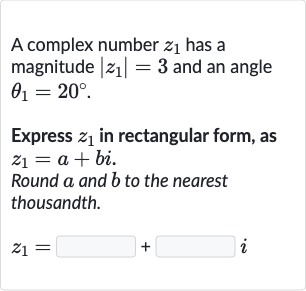Full solution
Q. A complex number has a magnitude and an angle .Express in rectangular form, as .Round and to the nearest thousandth.
- Convert to rectangular form: Convert the polar form of the complex number to rectangular form using the formula , where is the magnitude and is the angle.Given: and degrees.We need to calculate the cosine and sine of degrees.
- Calculate cosine and sine: Calculate the cosine and sine of degrees.Using a calculator or trigonometric tables:
- Multiply by magnitude: Multiply the cosine and sine values by the magnitude to get the real and imaginary parts of the complex number.
- Round to nearest thousandth: Round the real and imaginary parts to the nearest thousandth.
- Express in rectangular form: Express in rectangular form using the rounded values of and .
More problems from Compare linear and exponential growth
QuestionGet tutor help
QuestionGet tutor help
QuestionGet tutor help
QuestionGet tutor help
QuestionGet tutor help
QuestionGet tutor help
QuestionGet tutor help

